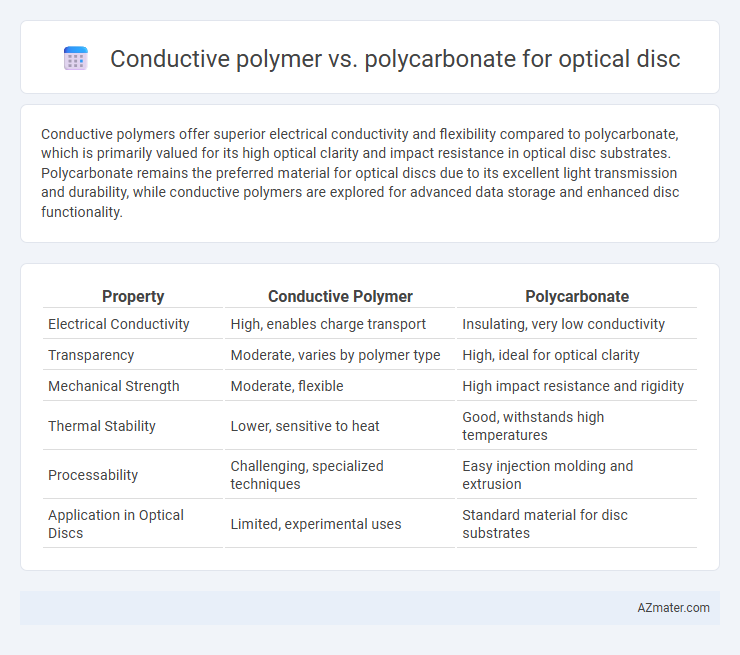Conductive polymers offer superior electrical conductivity and flexibility compared to polycarbonate, which is primarily valued for its high optical clarity and impact resistance in optical disc substrates. Polycarbonate remains the preferred material for optical discs due to its excellent light transmission and durability, while conductive polymers are explored for advanced data storage and enhanced disc functionality.
Table of Comparison
| Property | Conductive Polymer | Polycarbonate |
|---|---|---|
| Electrical Conductivity | High, enables charge transport | Insulating, very low conductivity |
| Transparency | Moderate, varies by polymer type | High, ideal for optical clarity |
| Mechanical Strength | Moderate, flexible | High impact resistance and rigidity |
| Thermal Stability | Lower, sensitive to heat | Good, withstands high temperatures |
| Processability | Challenging, specialized techniques | Easy injection molding and extrusion |
| Application in Optical Discs | Limited, experimental uses | Standard material for disc substrates |
Overview of Optical Disc Materials
Optical discs primarily utilize polycarbonate due to its excellent optical clarity, durability, and resistance to impact, providing a stable substrate for data encoding layers. Conductive polymers, although explored for their electrical properties and potential improvements in data reading efficiency, are less common because they typically lack the mechanical strength and transparency required for optical disc substrates. Polycarbonate remains the industry standard because it balances cost-effectiveness, manufacturability, and optical performance essential for reliable data storage and retrieval.
Introduction to Conductive Polymers
Conductive polymers are organic materials that combine the electrical properties of metals with the processing advantages of polymers, making them ideal for advanced optical disc applications. These polymers offer superior electrical conductivity, flexibility, and lightweight characteristics compared to traditional polycarbonate substrates, which are primarily used for their durability and optical clarity. Integrating conductive polymers in optical discs enhances data storage capabilities by improving signal transmission and reducing electromagnetic interference.
Introduction to Polycarbonate
Polycarbonate is a widely used polymer in optical disc manufacturing due to its excellent transparency, high impact resistance, and dimensional stability. It provides a smooth surface essential for precise laser reading and writing in CDs, DVDs, and Blu-ray discs. Compared to conductive polymers, polycarbonate offers superior optical clarity and mechanical strength, making it the preferred substrate for optical data storage.
Material Properties Comparison
Conductive polymers exhibit superior electrical conductivity and flexibility compared to polycarbonate, which offers exceptional optical clarity and dimensional stability ideal for optical disc substrates. While conductive polymers provide better electrochemical performance essential for rewritable media, polycarbonate's high impact resistance and thermal stability ensure durability and data integrity. The choice between these materials depends on prioritizing electrical functionality or mechanical robustness in optical disc applications.
Optical Transparency and Performance
Conductive polymers exhibit excellent optical transparency with adjustable conductivity, making them suitable for advanced optical disc applications requiring precise light transmission and signal processing. Polycarbonate offers high optical clarity, mechanical strength, and durability, ensuring reliable data storage and playback but lacks the inherent electrical conductivity of conductive polymers. For optimal optical disc performance, combining the transparency of polycarbonate with the conductive properties of polymers can enhance data accuracy and signal integrity.
Thermal and Mechanical Stability
Conductive polymers used in optical discs offer superior thermal stability due to their ability to withstand higher temperatures without degradation, ensuring consistent performance during high-speed data reading and writing. Polycarbonate, while widely used for optical disc substrates because of its excellent mechanical strength and impact resistance, exhibits lower thermal stability, leading to potential warping or deformation under prolonged heat exposure. Balancing thermal resistance and mechanical durability is critical, as conductive polymers provide enhanced heat tolerance, whereas polycarbonate ensures structural integrity and shock absorption in optical media applications.
Electrical Conductivity and Applications
Conductive polymers exhibit tunable electrical conductivity, making them suitable for advanced optical disc applications requiring efficient charge dissipation and signal transmission. Polycarbonate, with its excellent optical clarity and mechanical strength but inherently low electrical conductivity, is primarily used as a substrate material in standard optical discs. Industries leverage conductive polymers for next-generation optical storage devices that demand enhanced electromagnetic interference shielding and improved data integrity.
Manufacturing Processes and Costs
Conductive polymers offer easier processing through solution-based methods like spin coating and inkjet printing, reducing manufacturing complexity and enabling flexible optical disc substrates, but they generally incur higher material costs due to specialized synthesis. Polycarbonate, favored in optical disc manufacturing, is produced via injection molding, offering high throughput and low per-unit costs with well-established supply chains and consistent optical clarity. While conductive polymers provide innovative functionality, polycarbonate remains the industry standard for cost-effective mass production of optical discs due to its economical and scalable manufacturing processes.
Environmental Impact and Recycling
Conductive polymers in optical discs offer enhanced recyclability due to their potential for chemical depolymerization, reducing environmental burden compared to polycarbonate, which is less biodegradable and challenges standard recycling streams. Polycarbonate, widely used for optical disc substrates, generates persistent plastic waste and requires energy-intensive recycling processes, contributing to higher carbon emissions. Innovative conductive polymer formulations can enable eco-friendly disc production by facilitating closed-loop recycling and minimizing hazardous waste generation.
Future Trends in Optical Disc Materials
Future trends in optical disc materials emphasize the integration of conductive polymers for enhanced data storage and faster read/write speeds compared to traditional polycarbonate substrates. Conductive polymers offer improved electrical properties and greater resistance to thermal degradation, enabling higher-density optical discs with increased durability. Advances in nanotechnology and polymer chemistry are driving the development of hybrid materials that combine the mechanical strength of polycarbonate with the electronic conductivity of conductive polymers, promising a new generation of high-performance optical storage media.

Infographic: Conductive polymer vs Polycarbonate for Optical disc
 azmater.com
azmater.com